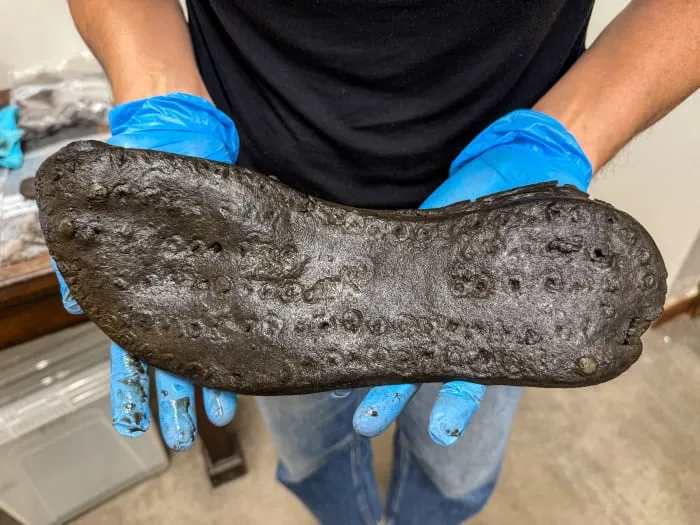Discovered near Hadrian’s Wall in northern England, the oversized leather footwear has left researchers puzzled
/https://tf-cmsv2-smithsonianmag-media.s3.amazonaws.com/accounts/headshot/SarahKuta.png)
Sarah Kuta - Daily Correspondent
July 28, 2025

When archaeologists unearth ancient shoes, the artifacts are usually about the same size as the footwear we use today. However, during recent excavations in northern England, researchers were surprised to find several massive leather shoes that are much larger than usual—and they have no idea why they’re so big.
The supersized footwear comes from a Roman-era fort called Magna, which is located along Hadrian’s Wall, the 73-mile stone fortification built beginning in 122 C.E. that marked the northwest boundary of the Roman Empire. Also known as Carvoran, the fort was operational from 85 C.E. to 122 C.E., according to the Roman Army Museum.
Since May, archaeologists working at Magna have unearthed eight massive leather shoes that each measure more than 11.8 inches long. The extra-large specimens now make up roughly a quarter of all the shoes found at the site so far.
Researchers discovered the first huge shoe while exploring a defensive ditch where Roman soldiers were also known to dump their trash. That shoe’s sole was 12.6 inches long, which is roughly the same size as a men’s 14 in the United States, reports Live Science’s Kristina Killgrove.
Archaeologists kept digging and found another 33 shoes of varying sizes, including some that appear to have been made for children. The longest shoe they found measures 12.8 inches long.
The soles are all made from thick sheets of cowhide leather that are held together by iron hobnails, reports CNN’s Kameryn Griesser. The shoes have been preserved for nearly 2,000 years because of the low-oxygen conditions of the soil in the region.
Researchers don’t know why some of the footwear at Magna is so large. They’ve also unearthed thousands of shoes at the nearby Roman fort of Vindolanda, but most of those were normal in size. Of the 3,704 measurable shoes discovered at Vindolanda, just 16 of them, or about 0.4 percent, were longer than 11.8 inches, per Live Science. For comparison, 25 percent of the shoes found at Magna so far have been more than 11.8 inches long.
The giant Magna shoes will probably shrink a little bit during the conservation process. But even if they lose 0.4 inches of length, which archaeologists say is standard, they’ll still be gigantic.
A big lasting impression: The Magna Roman Shoes

“We have to assume it’s something to do with the people living here, having bigger feet, being potentially taller—but we don’t know,” says Rachel Frame, the archaeologist leading the excavations at Magna, to BBC News’ Jason Arunn Murugesu. “Are the people living there from a specific region? Could that be why their shoes are so much larger? But at the moment, it’s sort of, well, this is unusual.”
There might be other possible explanations, according to Tim Penn, an archaeologist at the University of Reading who is not involved with the project. Maybe the massive shoes were worn by soldiers with swollen feet or other injuries that required them to wear medical dressings, Penn writes in the Conversation.
Alternatively, perhaps the shoes were winter boots that were meant to be worn with several pairs of socks or some kind of insulation. This theory, Penn writes, is supported by a preserved letter that refers to socks and underpants being sent to a soldier stationed there. Historians also know that archers from Syria lived at Magna, and it’s safe to assume that these men would have been accustomed to the cold climate of northern England, he adds.
Speaking to Agence France-Presse (AFP), Frame also emphasizes that individuals from different parts of the world were likely living and working at Magna two millennia ago.
“When people think about the Romans, they think about Italians,” Frame tells AFP. “They sometimes forget just how broad the empire was and how far it stretched.”
To figure out who was wearing the large footwear, researchers plan to study the wear patterns and foot impressions left behind in the shoes. These insights could help them work backward to model the feet of the original wearers. They also plan to date pottery and other artifacts found at Magna to better understand the site’s timeline, as well as who may have been living there at various points in history.
In the meantime, the shoes serve as a reminder “that not every population was the same, that wide variations between the regiments and people who served along Hadrian’s Wall, could be cultural and physical,” says Andrew Birley, CEO and director of excavations for the Vindolanda Trust, the organization that oversees Magna and Vindolanda, in a statement.
“We can only celebrate and marvel at the diversity and differences of these people if we can still see them in the archaeological data we gather today,” he adds.
.png)


